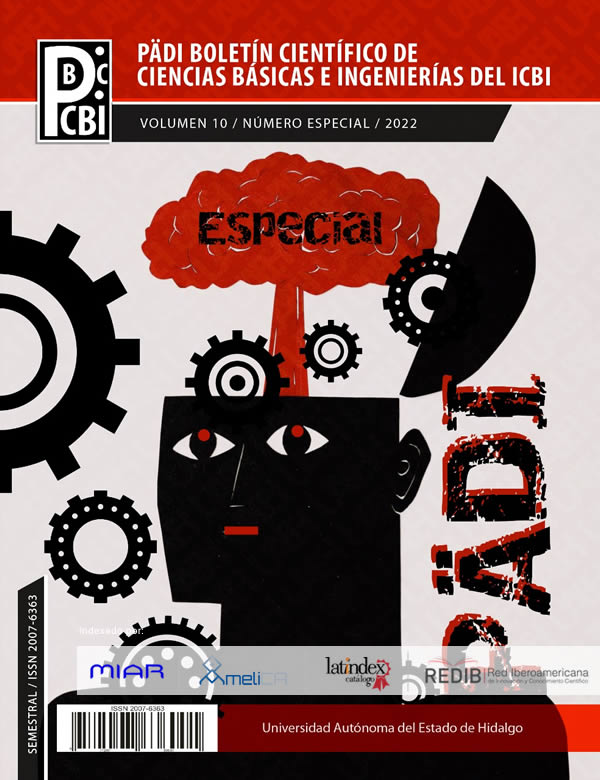Epidemiological models with vaccination control in the study of COVID-19
Abstract
This article analyzes the development and application of differential equations in the analysis of epidemics using the epidemiological models SIR and SEIR. In the first part of the work, the equations defined by both models are mathematically analyzed. Subsequently, the development of an epidemic is numerically simulated and compared with the predicted mathematical behavior. In the second part of the work, we study how to control the evolution of an epidemic by means of vaccination methods. First, the changes involved in the application of a vaccine in the equations are analyzed. Subsequently, these models are numerically simulated to analyze the evolution of the population under different vaccination schemes. Finally, the models are put into practice to study the evolution of the COVID-19 epidemic in Mexico.
Downloads
References
Andersson, H. and Britton, T. (2012). Stochastic epidemic models and their statistical analysis, volume 151. Springer Science & Business Media.
Bacaër,N.(2011). A Short History of Mathematical Population Dynamics. Springer Science & Business Media.
Bacaër, N., Ripoll, J., de la Parra, R. B., Bardina, X., and Cuadrado, S. (2021). Matemáticas y epidemias. Casini.
Brauer, F. (2017). Mathematical epidemiology: Past, present, and future. Infectious Disease Modelling, 2(2):113-127.
CDC (2021). Ending isolation and precautions for people with COVID-19: Interim guidance, centers for disease control and prevention.
Cherniha, R. and Davydovych, V. (2020). A mathematical model for the COVID-19 outbreak and its applications. Symmetry, 12(6):990.
Chu, J. (2021). A statistical analysis of the novel coronavirus (COVID-19) in italy and spain. PLoS ONE, 16(3):e0249037.
Earn, D., Rohani, P., Bolker, B., and Grenfell, B. (2000). A simple model for complex dynamical transitions in epidemics. Science, 287(5453):667–670.
Gumel, A., Iboi, E., Ngonghala, C., and Elbasha, E. (2021). A primer on using mathematics to understand COVID-19 dynamics: Modeling, analysis and simulations. Infectious Disease Modelling, 6:148–168.
Kermack, W. O. and McKendrick, A. G. (1927). A contribution to the mathematical theory of epidemics. Proceedings of the Royal Society of London. Series A, 115(772):700–721.
Li, M. and Muldowney, J. (1995). Global stability for the seir model in epidemiology. Mathematical Biosciences, 125:155–164.
Martcheva, M. (2015). An Introduction to Mathematical Epidemiology. Springer.
Martonosi, S., Behzad, B., and Cummings, K. (2021). Pricing the COVID-19 vaccine: A mathematical approach. Lancet Infect Dis, 21:793–802.
Moore, S., Hill, E., Tildesley, M., Dyson, L., and Keeling, M. (2021). Vaccination and non-pharmaceutical interventions for COVID-19: a mathematical modelling study. Omega, 103:102451.
Nåsell, I. (1999). On the time to extinction in recurrent epidemics. Journal of the Royal Statistical Society: Series B (Statistical Methodology), 61(2):309– 330.
Nesteruk, I. (2020). Statistics-based predictions of coronavirus epidemic spreading in mainland china. Innov Biosyst Bioeng, 4(1):13–18.
Olivares, A. and Staffetti, E. (2021). Uncertainty quantification of a mathematical model of COVID-19 transmission dynamics with mass vaccination strategy. Chaos, Solitons and Fractals, 146:110895.
Prodanov, D. (2021). Analytical parameter estimation of the sir epidemic mo- del. applications to the COVID-19 pandemic. Entropy, 25(59):e23010059.
Qi, H., Xiao, S., Shi, R., Ward, M. P., Chen, Y., Tu, W., Su, Q., Wang, W., Wang, X., and Zhang, Z. (2020). COVID-19 transmission in mainland china is as- sociated with temperature and humidity: a time-series analysis. Science of the total environment, 728:138778.
Tang, Y., Serdan, T., Masi, L., Tang, S., Gorjao, R., and Hirabara, S. (2020). Epidemiology of COVID-19 in brazil: Using a mathematical model to es- timate the outbreak peak and temporal evolution. Emerging Microbes & Infections, 9(1):1453–1456.
Van Herwaarden, O. A. and Grasman, J. (1995). Stochastic epidemics: major outbreaks and the duration of the endemic period. Journal of mathematical biology, 33(6):581–601.
Wang, J., Kaperak, C., Sato, T., and Sakuraba, A. (2021). COVID-19 reinfection: a rapid systematic review of case reports and case series. Journal of Investigative Medicine, 69(6):1253–1255.
WHO (2020). Novel coronavirus (2019-ncov): Situation report, 11. world health organization.
Zeroual, A., Harrou, F., Dairi, A., and Sun, Y. (2020). Deep learning methods for forecasting COVID-19 time-series data: A comparative study. Chaos, Solitons & Fractals, 140:110121.













